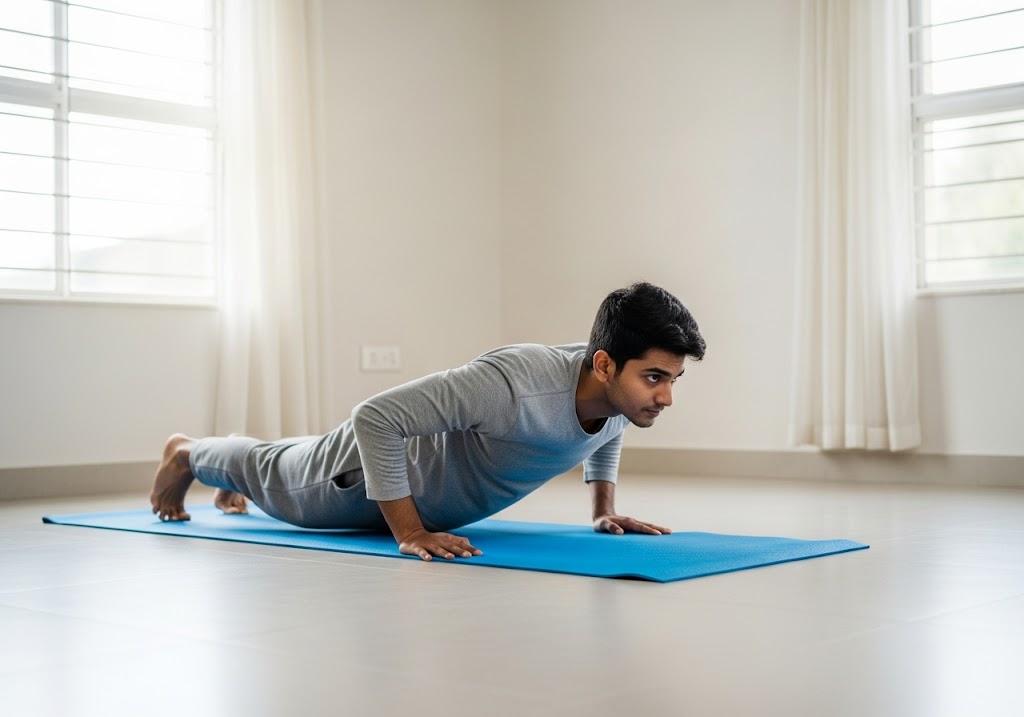20 resistance band core exercises are: Band Crunches for six-pack, Russian Twists for rotation, Dead Bugs for deep core, Bicycle Crunches for dynamic rotation, Plank Pull-apart for anti-extension, Wood Chops for power, Mountain Climbers for conditioning, Reverse Crunches for lower abs, Side Plank Band for lateral stability, Pallof Press for anti-rotation, Band Knee Raises for lower abs, Stability Ball Band Crunches for range, Band Bird Dog for stability, High Plank Band Rows for core + upper body, Band Side Bends for lateral flexion, Band Flutter Kicks for endurance, Band Leg Raises for strength, Band Hollow Body Hold for isometric core, Band V-Ups for power, Band Windshield Wipers for control.
Want to build a stronger, more defined core using resistance band core exercises that challenge your abs in ways traditional exercises cannot? These versatile training tools provide variable resistance and multi-directional challenges that target your entire core musculature for impressive strength and definition. Whether you’re seeking resistance band exercises for core stability or an intense ab workout using resistance bands, this complete training plan delivers results.
Table of Contents
20 Best Resistance Band Core Exercises
These twenty proven resistance band core exercises target every area of your core musculature for complete development and functional strength. Each exercise challenges different movement patterns while providing the variable resistance that makes band training uniquely effective.
Exercise Overview Table
| Exercise | Primary Target | Secondary Muscles | Difficulty | Equipment | Benefits |
|---|---|---|---|---|---|
| Band Crunches | Rectus Abdominis | Hip Flexors | Beginner | Tube Band | Six-pack development |
| Russian Twists | Obliques | Rectus Abdominis | Beginner | Tube Band | Rotational strength |
| Dead Bugs | Transverse Abdominis | Hip Flexors | Intermediate | Loop Band | Deep core stability |
| Bicycle Crunches | Obliques, Rectus Ab | Hip Flexors | Intermediate | Tube Band | Dynamic rotation |
| Plank Pull-apart | Transverse Abdominis | Shoulders, Back | Intermediate | Flat Band | Anti-extension strength |
| Wood Chops | Obliques | Shoulders, Lats | Intermediate | Tube Band | Power development |
| Mountain Climbers | Full Core | Shoulders, Legs | Advanced | Loop Band | Metabolic conditioning |
| Reverse Crunches | Lower Abs | Hip Flexors | Intermediate | Tube Band | Lower ab targeting |
| Side Plank Band | Obliques | Shoulders, Glutes | Advanced | Loop Band | Lateral stability |
| Pallof Press | Transverse Abdominis | Obliques | Advanced | Tube Band | Anti-rotation strength |
| Band Knee Raises | Lower Abs | Hip Flexors | Intermediate | Tube Band | Lower ab isolation |
| Stability Ball Band Crunches | Rectus Abdominis | Core Stabilizers | Advanced | Tube Band + Ball | Enhanced range of motion |
| Band Bird Dog | Transverse Abdominis | Glutes, Back | Intermediate | Loop Band | Posterior chain stability |
| High Plank Band Rows | Full Core | Lats, Rhomboids | Advanced | Tube Band | Core + Upper body |
| Band Side Bends | Obliques | Quadratus Lumborum | Beginner | Tube Band | Lateral flexion |
| Band Flutter Kicks | Lower Abs | Hip Flexors | Intermediate | Loop Band | Lower ab endurance |
| Band Leg Raises | Lower Abs | Hip Flexors | Advanced | Tube Band | Lower ab strength |
| Band Hollow Body Hold | Full Core | Hip Flexors | Advanced | Loop Band | Isometric strength |
| Band V-Ups | Full Core | Hip Flexors | Advanced | Tube Band | Dynamic core power |
| Band Windshield Wipers | Obliques | Hip Flexors | Advanced | Loop Band | Rotational control |
1. Band Crunches
Band crunches enhance traditional crunches by providing ascending resistance that maximizes muscle activation at the peak contraction. Anchor the band behind you and hold handles while performing controlled crunching movements. This resistance band core exercises variation builds impressive rectus abdominis strength and definition.
How to do?
- Anchor the band to a sturdy object behind you at floor level
- Lie on your back with knees bent and feet flat on the floor
- Hold band handles at chest level with arms crossed
- Engage your core and crunch forward against the band resistance
- Squeeze your abs at the peak contraction
- Lower slowly back to starting position maintaining tension
2. Russian Twists with Band
Russian twists with bands challenge your obliques through rotational resistance that builds core power and stability. Sit with knees bent and rotate the band from side to side against resistance. This dynamic exercise develops the rotational strength essential for athletic performance and daily activities.
How to do?
- Sit on the floor with knees bent and feet slightly lifted
- Hold the band handle with both hands at chest level
- Anchor the band to your side or have a partner hold it
- Lean back slightly to engage your core
- Rotate your torso from side to side against the band resistance
- Keep your core tight throughout the entire movement
3. Dead Bugs with Band
Dead bugs with bands target the deep transverse abdominis through anti-extension challenges that build core stability. Lie on your back with the band around your feet and perform alternating leg extensions. This exercise teaches proper core activation patterns while improving hip mobility.
How to do?
- Lie on your back with arms extended toward the ceiling
- Place a loop band around both feet with knees bent at 90 degrees
- Keep your lower back pressed against the floor
- Slowly extend one leg while keeping the other bent
- Maintain core tension to prevent back arch
- Return to starting position and switch legs
4. Bicycle Crunches with Band
Bicycle crunches with bands combine rotation and flexion for comprehensive oblique development through dynamic resistance patterns. The band adds complexity and resistance that traditional bicycle crunches cannot provide. Focus on controlled movement rather than speed for maximum muscle activation.
How to do?
- Lie on your back with the band anchored behind you
- Hold band handles and bring knees to 90-degree angle
- Perform alternating bicycle pedaling motion
- Rotate your torso to bring opposite elbow to knee
- Maintain constant tension on the band throughout
- Focus on controlled movement rather than speed
5. Plank with Band Pull-apart
Plank pull-aparts challenge anti-extension core strength while building upper body stability through dual-task training. Hold a plank position while performing band pull-aparts with your arms. This advanced exercise builds functional strength that transfers to real-world activities.
How to do?
- Get into a high plank position holding band handles
- Keep your body in a straight line from head to heels
- Pull the band apart by separating your hands horizontally
- Maintain plank position throughout the band movement
- Bring hands back together with control
- Keep core engaged to prevent hip sagging
6. Standing Wood Chops
Standing wood chops develop rotational power and core strength through diagonal movement patterns that mirror athletic activities. Pull the band from high to low across your body with core engagement throughout. This functional exercise builds the power needed for sports and daily rotation movements.
How to do?
- Anchor the band high and to one side
- Stand with feet shoulder-width apart
- Hold band handle with both hands overhead
- Rotate and pull the band diagonally across your body
- End with hands near opposite hip
- Reverse the movement back to starting position
7. Band Mountain Climbers
Mountain climbers with bands combine core training with cardiovascular conditioning through high-intensity dynamic movements. Place the band around your feet and perform rapid alternating knee drives. This exercise builds core endurance while improving overall fitness levels significantly.
How to do?
- Get into a high plank position
- Place a loop band around both feet
- Keep hands planted firmly on the ground
- Rapidly alternate bringing knees toward chest
- Maintain plank position throughout the movement
- Keep core tight to prevent hip bouncing
8. Reverse Crunches with Band
Reverse crunches with bands specifically target the lower abdominal region that many people struggle to develop effectively. Anchor the band overhead and perform reverse crunching movements against resistance. This exercise addresses the challenging lower abs through focused resistance training.
How to do?
- Lie on your back with band anchored overhead
- Place band around your feet or ankles
- Bend knees at 90 degrees with thighs perpendicular to floor
- Pull knees toward your chest against band resistance
- Focus on lifting hips off the ground slightly
- Lower legs back to starting position with control
9. Side Plank with Band
Side planks with bands challenge lateral core stability through isometric holds with added resistance complexity. Hold a side plank while performing band exercises with your top arm. This advanced variation builds incredible oblique strength and shoulder stability simultaneously.
How to do?
- Lie on your side in a side plank position
- Hold band handle with your top hand
- Anchor band at chest level or have partner hold it
- Maintain side plank while pulling band against resistance
- Keep hips elevated and body in straight line
- Perform band exercises while holding side plank position
10. Band Pallof Press
The Pallof press builds anti-rotation core strength through isometric challenges that teach proper spinal stabilization. Hold the band at chest level and resist rotation while extending arms forward. This exercise builds the core stability essential for injury prevention and performance.
How to do?
- Stand perpendicular to band anchor point
- Hold band handle at chest level with both hands
- Step away from anchor to create tension
- Extend arms straight out in front of you
- Resist the band’s pull trying to rotate your torso
- Hold the position then bring arms back to chest
11. Band Knee Raises
Band knee raises provide targeted lower abdominal training with added resistance that traditional knee raises cannot match. The band creates increasing tension as you lift your knees higher, maximizing lower ab activation throughout the entire range of motion.
How to do?
- Hang from a pull-up bar or use captain’s chair
- Place loop band around both feet
- Keep legs straight or slightly bent
- Raise knees toward chest against band resistance
- Focus on using abs rather than hip flexors
- Lower legs with control maintaining band tension
12. Stability Ball Band Crunches
Stability ball band crunches combine the instability of the ball with band resistance for enhanced core activation. The ball increases range of motion while the band provides ascending resistance throughout the movement pattern.
How to do?
- Sit on stability ball with band anchored behind you
- Walk feet forward until lower back is on the ball
- Hold band handles at chest or behind head
- Perform crunches against band resistance
- Use ball to increase range of motion
- Maintain balance on the ball throughout
13. Band Bird Dog
Band bird dog exercises challenge core stability while building posterior chain strength through anti-extension and anti-rotation patterns. The band adds resistance to the traditional movement while requiring enhanced stabilization.
How to do?
- Start in hands and knees position
- Place loop band around one foot and opposite hand
- Maintain neutral spine throughout movement
- Extend opposite arm and leg against band resistance
- Hold position while resisting band’s pull
- Return to starting position and switch sides
14. High Plank Band Rows
High plank band rows combine core stabilization with upper body pulling movements for comprehensive functional training. Maintain plank position while performing rowing movements against band resistance.
How to do?
- Get into high plank position facing band anchor
- Hold band handle with one hand
- Maintain plank while rowing band toward your ribs
- Keep hips level and core engaged throughout
- Control the return to starting position
- Complete reps on one side before switching
15. Band Side Bends
Band side bends target the obliques through lateral flexion movements with progressive resistance. This exercise builds the lateral core strength needed for spinal stability and athletic performance.
How to do?
- Stand on band with feet shoulder-width apart
- Hold handle with one hand, other hand on hip
- Keep torso upright and core engaged
- Bend laterally away from the band anchor
- Feel stretch in obliques on the opposite side
- Return to upright position against band resistance
16. Band Flutter Kicks
Band flutter kicks challenge lower abdominal endurance while building hip flexor strength through rapid alternating leg movements. The band provides constant resistance throughout the exercise duration.
How to do?
- Lie on your back with loop band around both feet
- Keep legs straight and slightly elevated
- Perform small, rapid alternating up and down kicks
- Maintain lower back contact with the floor
- Keep core tight throughout the movement
- Continue for desired time or repetitions
17. Band Leg Raises
Band leg raises provide intense lower abdominal training with ascending resistance that peaks at full leg elevation. This exercise builds significant lower ab strength while improving hip flexor mobility.
How to do?
- Lie on your back with band anchored overhead
- Place band around feet or ankles
- Keep legs straight throughout the movement
- Raise legs toward ceiling against band resistance
- Focus on lifting with lower abs, not hip flexors
- Lower legs with control maintaining tension
18. Band Hollow Body Hold
Band hollow body holds combine isometric core strength with band resistance for enhanced stability training. This exercise builds the foundational core strength needed for advanced gymnastics and athletic movements.
How to do?
- Lie on your back in hollow body position
- Place loop band around feet with arms overhead
- Press lower back into floor and lift shoulders up
- Hold position while maintaining band tension
- Keep legs straight and slightly elevated
- Breathe steadily while holding the position
19. Band V-Ups
Band V-ups provide dynamic full-core training through simultaneous hip and spinal flexion against resistance. This advanced exercise builds explosive core power while challenging coordination and balance.
How to do?
- Lie on your back with band anchored behind you
- Hold band handles and extend arms overhead
- Simultaneously lift legs and upper body toward center
- Reach for your feet while maintaining band tension
- Focus on folding at the waist like closing a book
- Lower with control back to starting position
20. Band Windshield Wipers
Band windshield wipers challenge rotational core strength through controlled lateral movement patterns. This advanced exercise builds oblique strength while improving spinal mobility and control.
How to do?
- Alternate sides in controlled windshield wiper motion
- Lie on your back with arms extended for stability
- Place loop band around feet with legs elevated
- Keep knees slightly bent throughout movement
- Lower legs to one side while maintaining upper body contact
- Use core strength to return to center position
For developing the back strength that supports core training, how to get a wider back provides essential exercises for balanced development.
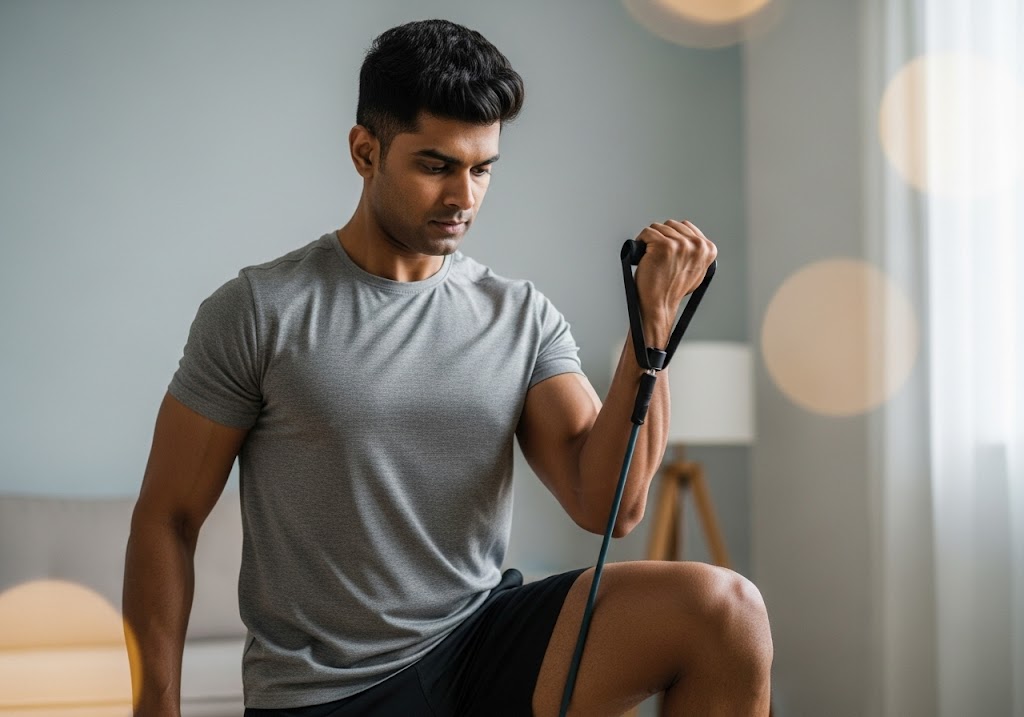
Anatomy of the Core Muscles
Understanding core anatomy helps maximize the effectiveness of resistance band core exercises by targeting specific muscle groups through appropriate movement patterns. The core consists of multiple muscle layers that work together to provide stability, power transfer, and spinal protection during daily activities and athletic movements.
The rectus abdominis, commonly known as the “six-pack” muscles, runs vertically along the front of your abdomen and performs spinal flexion. The external and internal obliques wrap around your sides and handle rotational movements and lateral flexion. The transverse abdominis acts as your body’s natural weight belt, providing deep stability and intra-abdominal pressure.
| Muscle Group | Primary Function | Resistance Band Exercise | Training Focus |
| Rectus Abdominis | Spinal flexion | Band crunches | Forward bending |
| External Obliques | Rotation, side bending | Russian twists | Rotational power |
| Internal Obliques | Rotation, stabilization | Wood chops | Anti-rotation |
| Transverse Abdominis | Deep stabilization | Dead bugs | Core stability |
| Erector Spinae | Spinal extension | Reverse hyperextensions | Back strength |
| Diaphragm | Breathing, stability | Band breathing exercises | Core activation |
The deeper core muscles including the multifidus, pelvic floor, and diaphragm work continuously to maintain spinal alignment and provide the foundation for all movement. Resistance band core exercises effectively target these muscles through unstable resistance that challenges your body’s stabilization systems.
For comprehensive bodyweight training that complements resistance band core exercises, exploring calisthenics exercises provides excellent foundation movements for total body strength.
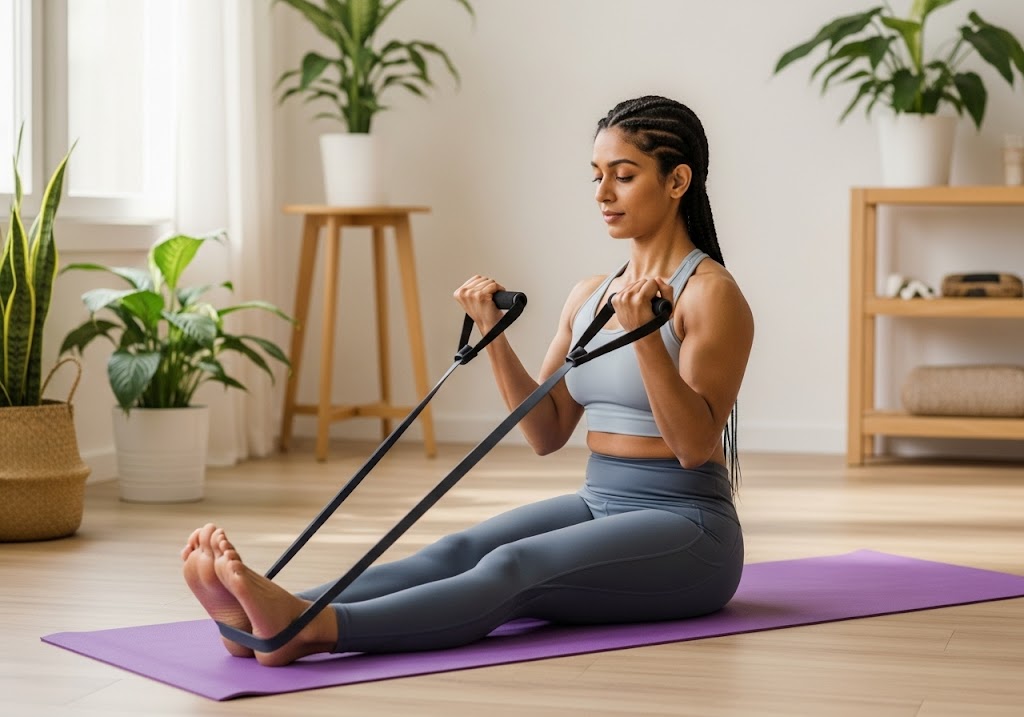
Benefits of Training Resistance Band Core Exercises
Training with resistance band core exercises provides unique advantages that traditional ab exercises cannot match for complete core development. These benefits extend beyond aesthetics to include functional strength, injury prevention, and athletic performance enhancement through targeted muscle activation.
- Variable Resistance: Bands provide increasing tension throughout the range of motion, maximizing muscle activation at peak contraction points for superior development in resistance band core exercises
- Multi-Directional Training: Unlike gravity-dependent exercises, bands allow core training in all planes of movement for comprehensive strength development
- Joint-Friendly Approach: Smooth resistance curves reduce spinal stress while maintaining muscle tension for safer long-term training progression
- Functional Movement Patterns: Band exercises mirror real-world activities that require core stability and rotational strength for daily life applications
- Progressive Difficulty: Easily adjust resistance levels and exercise complexity to match current fitness level and continue challenging muscles over time
- Portable Convenience: Complete core workouts anywhere without bulky equipment, perfect for travel or home training consistency
- Enhanced Muscle Activation: Unstable resistance forces deeper stabilizing muscles to work harder than traditional exercises can provide in resistance band core exercises
- Injury Prevention: Improved core stability and strength reduces risk of back pain and movement-related injuries significantly
Find out how many calories burned jumping jacks and the exact numbers for how many calories burn in skipping, including how many calories burn in 1000 skipping.

Sample Core Resistance Band Core Exercises Routine With Bands
This comprehensive routine incorporates the most effective resistance band core exercises for complete abdominal development. Perform this workout 3-4 times per week with at least one day of rest between sessions for optimal recovery and strength progression.
| Exercise | Sets | Reps/Time | Rest | Focus | Progression |
| Band Crunches | 3 | 15-20 | 45s | Upper abs | Add resistance |
| Russian Twists | 3 | 20-30 | 45s | Obliques | Increase speed |
| Dead Bugs | 3 | 10/side | 60s | Deep core | Hold longer |
| Wood Chops | 3 | 12/side | 60s | Rotational power | Heavier band |
| Plank Pull-apart | 3 | 30-45s | 60s | Anti-extension | More reps |
| Mountain Climbers | 3 | 20-30 | 30s | Conditioning | Faster pace |
| Pallof Press | 2 | 10/side | 45s | Anti-rotation | Hold position |
| Side Plank Band | 2 | 20-30s/side | 45s | Lateral stability | Add movements |
Perform exercises in circuit fashion for increased metabolic demand and time efficiency. Rest 2-3 minutes between complete circuits to maintain training intensity throughout the entire resistance band core exercises workout session while allowing adequate recovery.
For those interested in male-specific training approaches, resistance band workouts for men provides additional exercises and programming strategies for resistance band core exercises development.
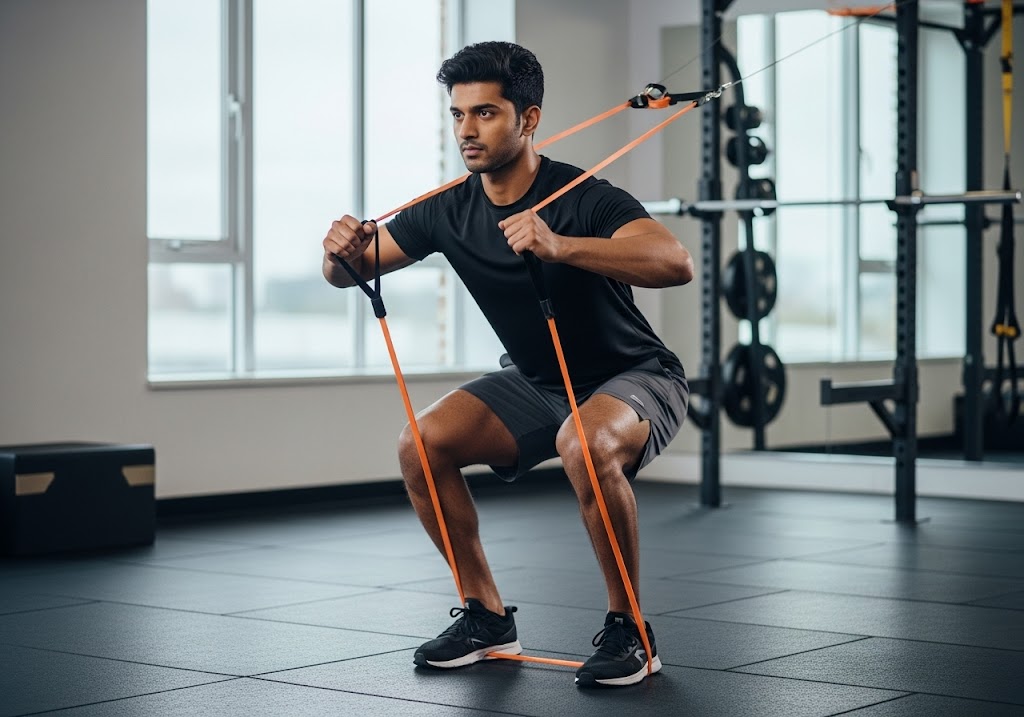
Best Bands For Training Resistance Band Core Exercises
Selecting appropriate bands for resistance band core exercises ensures optimal training stimulus while maintaining safety and durability throughout intense core training sessions. Different band types offer unique advantages for specific core training applications and exercise variations.
| Band Type | Best For Core Training | Resistance Levels | Advantages | Considerations |
| Tube Bands | Dynamic movements | Light to Heavy | Versatile, handles | May snap with age |
| Loop Bands | Lower body core work | Light to Medium | Compact, durable | Limited exercises |
| Flat Bands | Rehabilitation, stretching | Light | Gentle on joints | Lower resistance |
| Figure-8 Bands | Upper body core | Medium | Comfortable grip | Single resistance |
| Power Bands | Advanced training | Heavy to Extra Heavy | Maximum resistance | Requires experience |
Build strength with a resistance band bicep workout
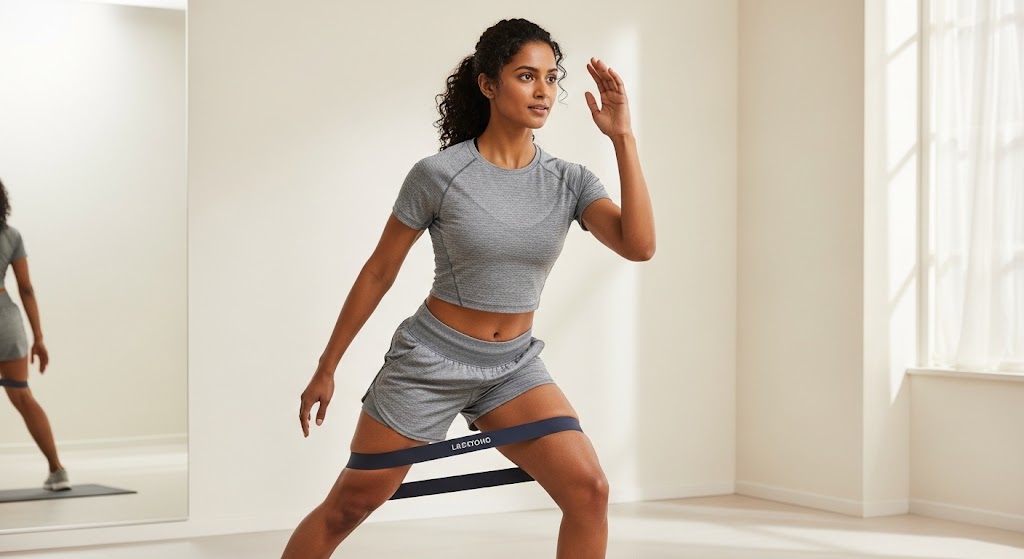
Resistance Band Exercises for Core Beginners
Beginning your journey with resistance bands core exercises for beginners requires proper progression and technique mastery before advancing to complex movements. Start with basic exercises that teach fundamental core activation patterns while building strength gradually through proper band setup and tension management.
| Beginner Phase | Duration | Focus | Key Exercises | Progression Marker |
| Week 1-2 | Form learning | Basic activation | Band crunches, dead bugs | Perfect form |
| Week 3-4 | Strength building | Controlled movement | Add Russian twists | 15+ reps |
| Week 5-6 | Coordination | Multiple planes | Wood chops, side bends | Smooth execution |
| Week 7-8 | Integration | Combination moves | Plank variations | Exercise linking |
Start each session with gentle activation exercises to prepare your core muscles for more intensive training. End with stretching and breathing exercises to promote recovery and maintain mobility between resistance band core exercises training sessions.
For comprehensive beginner-friendly approaches, understanding the best resistance band core exercises for beginners ensures safe progression and optimal results from your training efforts. Additionally, exploring unilateral exercises provides excellent single-sided challenges that complement core development.
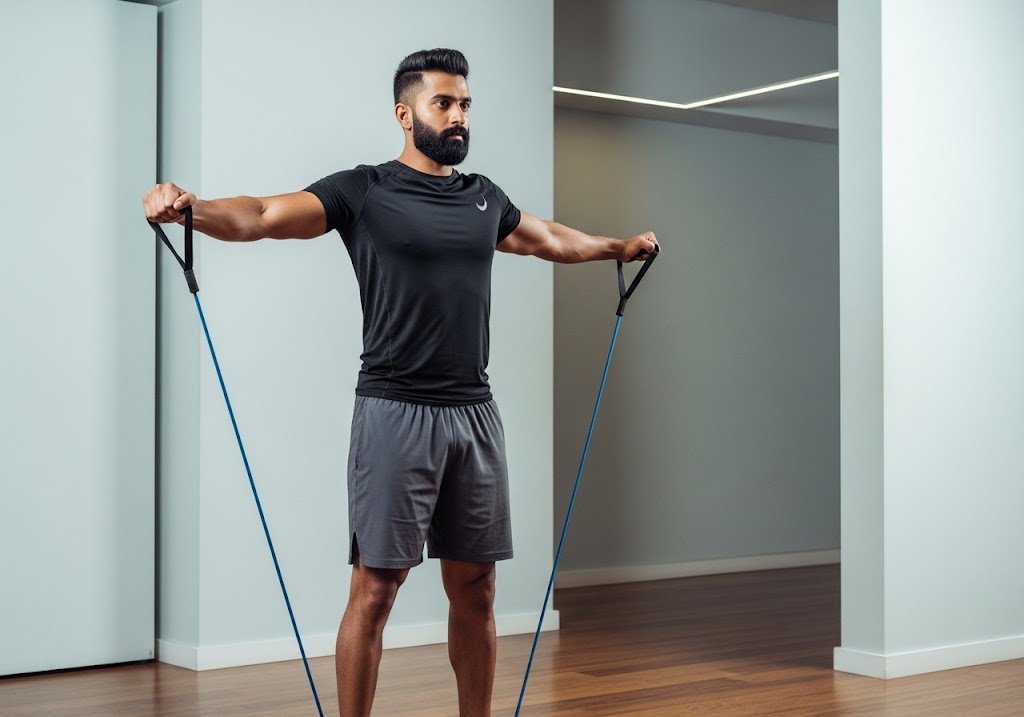
Resistance Band Workouts for Abs
Developing impressive abs requires targeted resistance band workouts for abs that challenge the rectus abdominis through various angles and resistance patterns. Successful ab development requires progressive overload through increased resistance, repetitions, or exercise complexity while combining isolation and compound movements for complete six-pack development.
| Ab Focus Area | Best Band Exercises | Sets x Reps | Training Frequency |
| Upper Abs | Band crunches, sit-ups | 3 x 15-20 | 3-4x per week |
| Lower Abs | Reverse crunches, leg raises | 3 x 12-15 | 3-4x per week |
| Full Rectus | Bicycle crunches, mountain climbers | 3 x 20-30 | 2-3x per week |
| Definition | High-rep circuits | 4 x 25+ | 2x per week |
For female-specific training considerations, exploring resistance band workouts for women provides tailored approaches for optimal resistance band core exercises results.
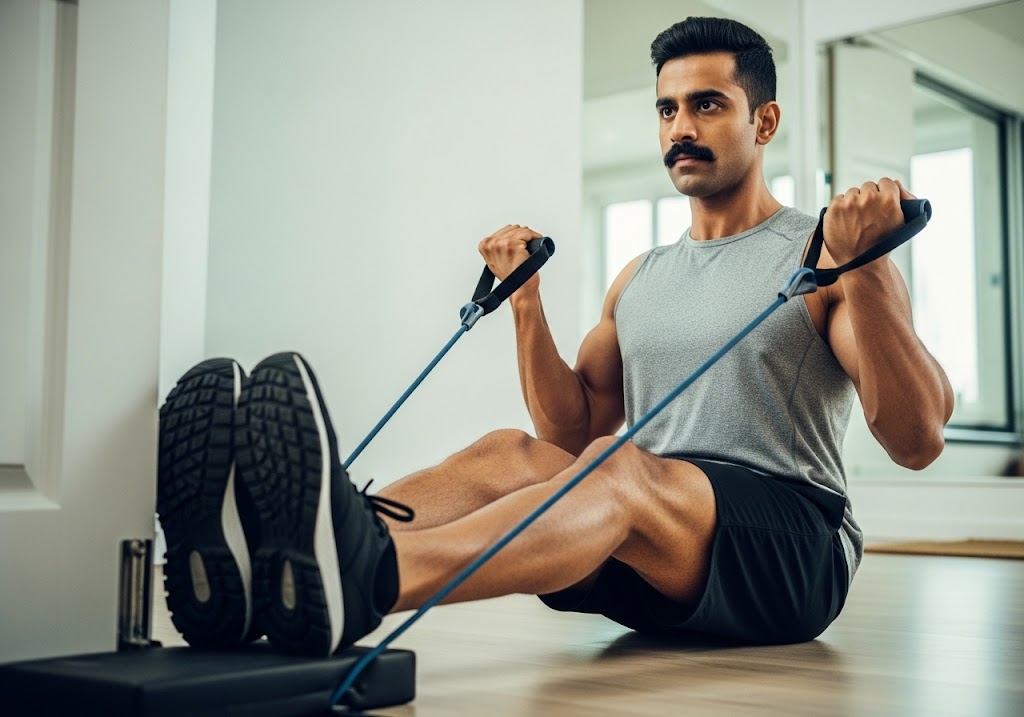
Lower Abs Workout with Resistance Band
Targeting the lower abs requires specific lower abs workout with resistance band techniques that emphasize reverse movement patterns where legs move toward the torso. Band resistance provides accommodating resistance that increases difficulty as muscles shorten, perfectly matching the strength curve for optimal lower abdominal activation.
- Reverse Crunches with Band: Anchor the band overhead and perform controlled reverse crunches against resistance. Focus on using your abs to pull your knees toward your chest rather than using momentum or hip flexors for the movement.
- Band Leg Raises: Lie on your back with the band around your feet and perform controlled leg raises against resistance. Keep legs straight and use your lower abs to lift your feet toward the ceiling while maintaining constant tension.
- Hanging Knee Raises with Band: If you have access to a pull-up bar, add band resistance to hanging knee raises for increased difficulty. The band provides additional resistance that challenges your grip and core simultaneously through enhanced resistance band core exercises variations.
For comprehensive core development that includes back strength, calisthenics back exercises provides essential posterior chain exercises that support resistance band core exercises development.

How to Train Core with Resistance Bands?
Learning how to train core with resistance bands effectively requires understanding elastic resistance properties that increase throughout the range of motion. Progressive overload involves increasing resistance level, repetitions, or exercise complexity, while higher training frequency is possible due to reduced joint stress.
| Training Variable | Band-Specific Approach | Traditional Difference | Application |
| Resistance | Accommodating (increases) | Constant weight | Peak contraction emphasis |
| Progression | Multi-factorial | Weight increases | Creative advancement |
| Recovery | Faster due to joint-friendly | Longer due to loading | Higher frequency possible |
| Muscle Activation | Throughout range | Position dependent | Complete development |
Focus on maintaining constant tension throughout each exercise rather than allowing the band to go slack at any point. This constant tension provides the unique benefit that makes resistance band core exercises superior to many traditional alternatives.
For understanding movement patterns that support core development, how to do a perfect squat provides essential technique guidance for functional strength that complements resistance band core exercises training.
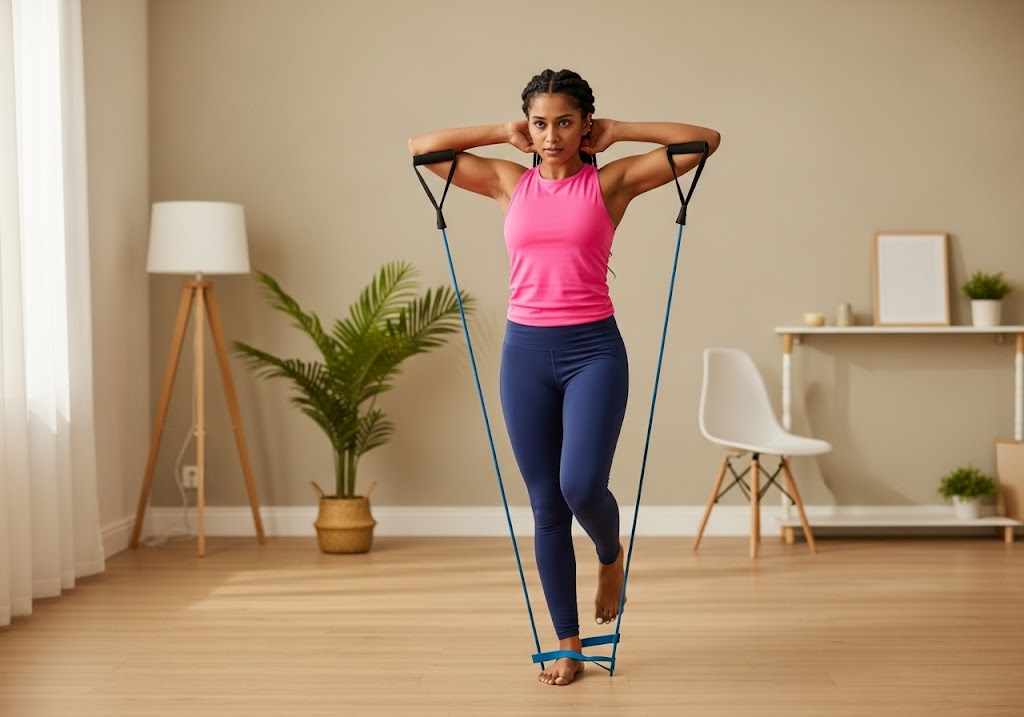
Best Core Exercises With Bands Sample Workout
This advanced sample workout combines the best resistance band core exercises in a comprehensive routine that challenges all core muscle groups. Perform this workout when you’ve mastered basic movements and need greater challenges for continued progression.
Workout A: Strength Focus (3x per week)
- Band Crunches: 4 sets x 15-20 reps
- Russian Twists: 4 sets x 30 total
- Dead Bugs: 3 sets x 12 each side
- Wood Chops: 3 sets x 10 each side
- Pallof Press: 3 sets x 8 each side
Workout B: Endurance Focus (2x per week)
- Mountain Climbers: 4 sets x 30 seconds
- Bicycle Crunches: 4 sets x 40 total
- Side Plank Band: 3 sets x 30s each side
- Band Crunches: 3 sets x 25 reps
- Russian Twists: 3 sets x 50 total
Circuit Option: Time-Efficient (2x per week)
Perform each exercise for 45 seconds with 15 seconds rest, complete 3-4 rounds:
- Band Crunches
- Russian Twists
- Mountain Climbers
- Wood Chops
- Dead Bugs
- Plank Pull-aparts
For those interested in advanced bodyweight challenges, exploring calisthenics planche provides incredible core strength development through isometric holds that complement resistance band core exercises perfectly.
What Are the Muscles of the Core?
The core encompasses far more than visible “six-pack” muscles, including deep stabilizers, posterior muscles, and the diaphragm that work together for complete spinal stability. Understanding this complexity helps design more effective resistance band core exercises that target all necessary muscle groups comprehensively.
| Muscle Layer | Muscles Included | Primary Functions | Band Training Benefits |
| Superficial | Rectus abdominis, external obliques | Movement, power | Visible development |
| Deep | Transverse abdominis, internal obliques | Stability, pressure | Functional strength |
| Posterior | Erector spinae, multifidus | Extension, stability | Balanced development |
| Supporting | Diaphragm, pelvic floor | Pressure, stability | Complete integration |
For understanding movement patterns that support core development, how to do a perfect squat provides essential technique guidance for functional strength.
The Best Resistance Band Core Exercises for Stronger Core
Building a truly strong core requires combining the best resistance band core exercises in systematic progression that challenges all muscle groups and movement patterns. This approach ensures complete development rather than focusing solely on visible muscles or single-plane movements. Strength progression involves both increasing resistance and advancing exercise complexity through multi-planar challenges, beginning with basic flexion patterns before progressing to rotation and combination movements.
The strongest cores develop through consistent training that progressively challenges stabilization, force production, and endurance across all movement patterns. Resistance bands provide the variable resistance and multi-directional challenges necessary for complete core strength development. Advanced practitioners should incorporate single-limb challenges and unstable surface training to further enhance core activation, mirroring real-world demands where core stability must be maintained while extremities perform various tasks.
For exploring single-limb training concepts that enhance core development, unilateral vs bilateral training provides excellent guidance for balanced resistance band core exercises development.
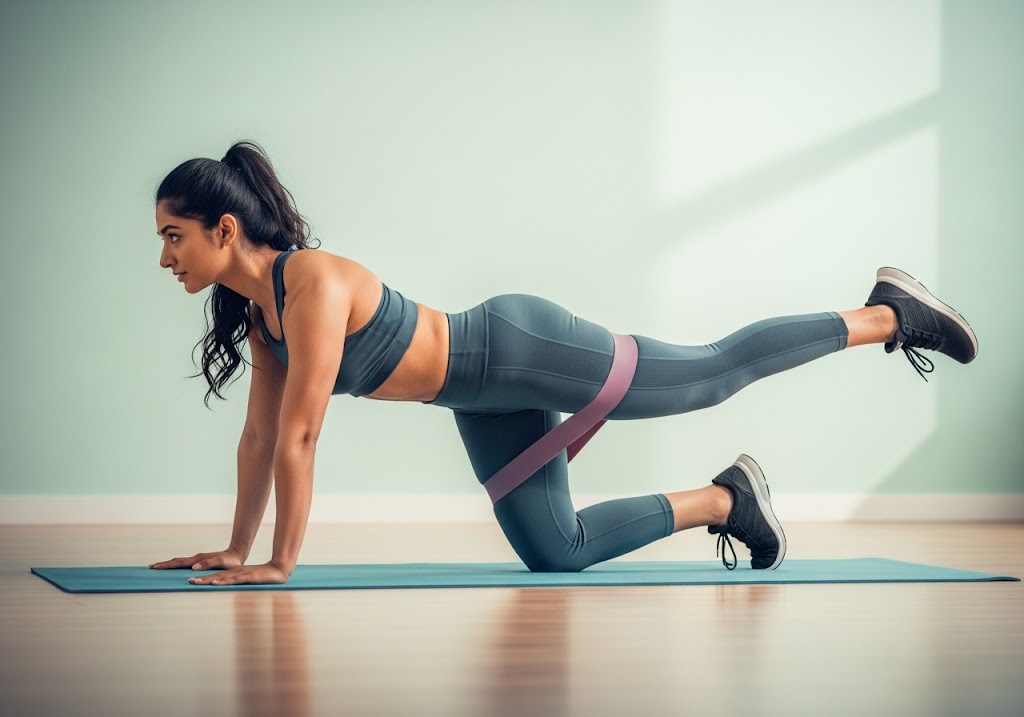
Common Mistakes in Resistance Band Core Exercises
Avoiding common mistakes in resistance band core exercises ensures optimal results while preventing injury and training plateau effects. These errors often limit the effectiveness of band training and can lead to imbalanced development or compensation patterns.
- Allowing Band Slack: Letting resistance go loose during exercises eliminates the constant tension that makes resistance band core exercises uniquely effective for core development
- Using Momentum: Rushing through movements reduces muscle tension and eliminates the controlled resistance that builds strength most effectively in resistance band core exercises
- Neglecting Deep Muscles: Focusing only on superficial muscles while ignoring transverse abdominis and other deep stabilizers limits functional strength development
- Poor Breathing Patterns: Holding breath during exercises reduces core activation and limits the integration of breathing with movement patterns
- Insufficient Progression: Using the same resistance and exercises without advancement prevents continued strength and muscle development over time
- Ignoring Multi-Planar Training: Training only in single planes limits functional strength and leaves weaknesses in rotational and lateral movement patterns in resistance band core exercises
For comprehensive training approaches that avoid these mistakes, understanding unilateral vs bilateral training provides excellent guidance for balanced development.

Nutrition Support for Core Development
Proper nutrition supports muscle building and fat loss necessary to reveal core strength developed through resistance band core exercises. While training builds muscle, nutrition determines whether that muscle becomes visible through appropriate body composition management and strategic dietary planning for optimal results.
| Nutrition Factor | Target | Purpose | Food Sources |
| Protein | 1.6-2.2g/kg daily | Muscle recovery and growth | Chicken, Fish, Eggs, Legumes |
| Calorie Deficit | 300-500 below maintenance | Fat loss for ab visibility | Whole foods, portion control |
| Hydration | 35ml/kg bodyweight | Performance and recovery | Water, herbal teas |
| Meal Timing | Pre/post workout | Energy and recovery | Carbs before, protein after |
For comprehensive approaches to body composition management that support resistance band core exercises visibility, exploring intermittent fasting plan provides structured approaches for fat loss while maintaining muscle.
Integration with Full Body Training
Resistance band core exercises integrate perfectly with full-body training programs that address all major muscle groups for complete fitness development. Core strength supports all other movements while full-body training provides the metabolic demands necessary for body composition improvements and enhanced performance.
- Warm-up Integration: Use resistance band core exercises as activation exercises before compound movements to prepare the core for heavy lifting
- Superset Addition: Pair core exercises with opposing muscle group training to maximize workout efficiency and maintain training intensity
- Circuit Training: Include core exercises in full-body circuits for metabolic conditioning while building strength and endurance simultaneously
- Active Recovery: Perform light resistance band core exercises on rest days to maintain movement quality and promote blood flow
- Compound Movement Support: Strong core from band training enhances performance in squats, deadlifts, and other compound exercises significantly
- Portable Solutions: Bands allow core training integration regardless of location or available equipment for consistent training adherence
For comprehensive programming that integrates resistance band core exercises effectively, full body calisthenics workout provides excellent foundation routines for complete development that supports resistance band core exercises training.
Advanced Techniques and Progressions
Advanced resistance band core exercises incorporate complex movement patterns, multiple resistance angles, and challenging stability requirements that push core strength to new levels. These progressions require mastery of basic movements before implementation for safety and effectiveness in developing superior core strength.
- Combination Exercises: Merge multiple movement patterns like squat-to-press with core rotation for greater challenges and improved coordination
- Tempo Variations: Use slow eccentrics, pause reps, and explosive concentrics to challenge muscles through different mechanisms and time domains
- Unilateral Challenges: Single-limb variations create asymmetrical loading that requires maximum core activation to maintain spinal alignment and stability
- Multi-Planar Training: Combine sagittal, frontal, and transverse plane movements in single exercises for comprehensive three-dimensional core development
- Instability Integration: Add unstable surfaces or multiple bands to increase proprioceptive demands and deep stabilizer muscle activation
- Plyometric Elements: Include explosive movements with bands to develop core power and rapid force production capabilities
For advanced upper body challenges that complement resistance band core exercises development, exploring resistance band workout for triceps provides specialized arm training techniques that support core stability.
Conclusion
Resistance band core exercises provide an incredibly effective and versatile approach to building core strength, stability, and muscle definition. From basic resistance bands core exercises for beginners to advanced techniques that challenge even experienced athletes, bands offer unique training benefits that traditional exercises cannot match. Whether you’re seeking an ab workout using resistance bands or comprehensive core development, the variable resistance and multi-directional challenges ensure complete muscle activation and functional strength that transfers to real-world activities and athletic performance for impressive resistance band core exercises results.
Want to master the calisthenics handstand and take your skills to the next level? Whether you’re a beginner or pushing advanced skills, ISC – Indian School of Calisthenics offers expert guidance to help you master bodyweight training. Visit us at SRPF Ground, NH8, Goregaon (E), Mumbai – 400065. For class schedules, personalized coaching, or more details, call +91 77159 53218. Train smart, move better, and unlock your back strength with ISC.
Resistance Band Core Exercises – FAQs
Do resistance bands work your core?
Yes, resistance bands effectively work your core through variable resistance and multi-directional challenges that activate stabilizing muscles more than traditional exercises.
What is the 1 most effective abs workout?
The most effective abs workout combines multiple exercises targeting all core muscles, with band crunches and planks being particularly effective single exercises.
Do resistance bands work for belly fat?
Resistance bands help build muscle and burn calories but cannot spot-reduce belly fat; diet remains the primary factor for fat loss.
How do I tone my stomach with resistance bands?
Combine resistance band core exercises with proper nutrition and cardio for muscle building and fat loss to achieve stomach toning.
What is the best band core exercise?
The Pallof press is often considered the best band core exercise as it builds anti-rotation strength essential for functional stability.
Is a resistance band really effective?
Yes, research shows resistance bands can be as effective as weights for building strength and muscle when used with proper intensity.
Can I get in shape with resistance bands?
Yes, resistance bands can provide complete fitness training including strength, muscle building, and cardiovascular conditioning for getting in shape.
How to resistance train abs?
Use progressive overload with bands through increased resistance, reps, and exercise complexity while maintaining proper form throughout movements.
Do resistance bands tone you?
Yes, resistance bands build muscle and can help achieve muscle tone when combined with appropriate nutrition for body composition goals.
How to do dead bugs abs?
Lie on back with band around feet, extend opposite arm and leg while maintaining core stability and neutral spine position.
Do resistance bands break?
Quality bands can last years with proper care, though all bands eventually wear out and should be inspected regularly for safety.
How to do crunches with bands?
Anchor band behind you, hold handles at chest, and perform crunching motion against increasing resistance for enhanced muscle activation.
Do resistance bands build speed?
Yes, bands can improve speed through explosive training and plyometric exercises that develop rapid force production and power.
What muscles do resistance bands target?
Resistance bands can target every major muscle group including core, arms, legs, back, and shoulders through various exercise modifications.

